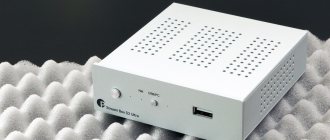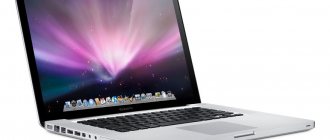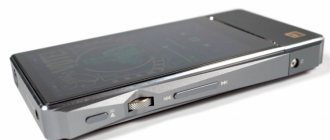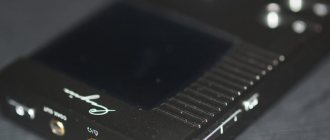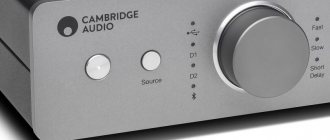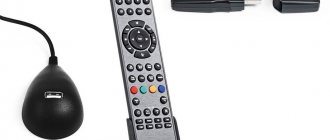Sometimes it just takes a few tweaks to improve an already great piece. This is exactly what Cambridge Audio did with the second generation of its CXN network player, which won an Award in 2015.
Save and read later -
In addition to built-in Tidal and Spotify Connect, you can now use Google Chromecast to stream music to the Cambridge Audio CXN (V2).
Cambridge Audio CXNNetwork player
Network Player
The main purpose of the player under consideration is the flawless reproduction of all common audio formats from any source with impeccable quality. The design of the device allows for long-term operation, including in conjunction with other Cambridge Audio CX series devices - for example, with an amplifier. The model is a universal streamer that plays Internet radio programs, supports the Spotify Connect service, and, using the Airplay function, can wirelessly receive streaming audio from Apple devices. For Bluetooth connection, the BT100 USB module with support for the aptX codec is optionally available. The model can connect to a local network via LAN or WLAN interfaces and play audio files from computers/servers. Any formats are supported, incl. FLAC and WAV in 24 bit/192 kHz resolution. You can control the streamer not only from the remote control or front panel, but also through the Cambridge Connect App with an intuitive interface and advanced capabilities.
Cambridge Audio CXN Network Desktop Audio Player
We got acquainted with household appliances produced by Cambridge Audio not so long ago using the example of the universal media player Azur725BD. A brief description of this technique looks like this: exclusive. Indeed, first-class case materials, high-quality electronic components, proprietary sound processing technologies - all these are signs of elitism. In fairness, we add: a high price is also one of these signs.
Someone, seeing the player in question, will probably ask the question: “What can this machine do that my smartphone can’t do?” You can answer, for example, like this: “Can your smartphone serve as an audio source for your own smartphone? Does it have a choice of audio inputs, audio outputs and built-in internet services?” But in general, of course, the question was asked quite reasonably. It's just not well thought out. Comparing a stationary Hi-End device with an everyday pocket machine is, at the very least, wrong. And the smartphone... Let it stay. Moreover, we will also need it to control this player.
- Completeness, design
- Settings, interface
- Exploitation
- conclusions
Completeness, design
The cover and chassis of the device are made of metal, and the front panel is made of brushed aluminum and contains a display with an unusually large diagonal, which is also color. To the left and right of the display there are player control buttons that allow you to perform basic operations.
The player's complete set can be defined as meager, and rightly so - if the potential buyer already has a speaker system and is an audiophile, then this system is probably equipped with all the necessary cables, and of high quality. And extra wires and other spills just get in the way. Here you can find only the basic, most necessary accessories for installation:
- power cable
- short RCA cable for connecting and controlling other CX series devices
- remote control with batteries
- USB Wi-Fi adapter with antenna
- quick user guide
- Spotify flyer
In addition to a large display with control buttons, on the front panel there is a button to turn the device on/off and a USB 2.0 port for connecting storage devices. On the opposite side of the panel from the display there is a rotating disk with a pressing function; it is used to navigate through menus or lists and confirm selections.
The rear panel of the device contains the following connectors and interfaces:
- power socket
- two USB ports for connecting the supplied Wi-Fi adapter and USB storage media (flash drive, disk)
- Ethernet port
- digital audio inputs: coaxial and optical
- input for connecting an external IR command receiver
- digital audio outputs: coaxial and optical
- Control bus connectors for connecting to other CX series devices (features vary depending on other products)
- USB audio input
- balanced XLR audio output
- line audio output
A characteristic feature is the duplication of inscriptions near each connector, made upside down. This is done so that the user, looking at the rear panel from above, can read the name of the desired port or connector.
The player is equipped with two rubber supports, and the role of the third support is played by the front panel extended downwards.
The electronics of the player are divided into two blocks - a board with audio connectors and a power section. Significant free space inside the device allows you to avoid overheating during long operation.
The rubber buttons of the IR remote control are logically divided into three blocks. The remote control is not backlit, and the text on the buttons may seem too small if you're not used to it. This remote control can control not only the specific player in question, but also any CX series device (amplifier, etc.).
The included Wi-Fi adapter connects to a specially designated USB input on the player.
This adapter complies with 802.11b/g/n standards and can support wireless communication at speeds up to 150 Mbps. In our case, with a standard single-band access point with one antenna, this speed was 135 Mbit/s.
The main technical characteristics of the audio player are shown in the following table; this and other information can be seen on the product page.
| Architecture | |
| DAC | 2 × Wolfson WM8740 DAC, 24 bit 192 kHz |
| Analog filter | two-pole dual differential Bessel filter |
| Digital filter | second generation ATF2 upsampling to 24 bit/384 kHz |
| Playback | |
| Audio formats | ALAC, WAV, FLAC, AIFF, WMA, MP3, AAC, HE AAC, AAC+, OGG Vorbis |
| Interfaces | |
| Inputs |
|
| Exits |
|
| USB | 3 × USB 2.0 |
| Net |
|
| Data sources, support |
|
| Other characteristics | |
| Mobile control software | Cambridge Connect (Android, iOS) |
| Display | built-in color, diagonal 4.3″ (11 cm), TFT |
| power unit | built-in, consumption up to 30 W in operating mode (0.5 W in idle mode) |
| Dimensions (W×D×H), weight | 430×305×85 mm, 3.5 kg |
| average price | T-12402851 |
| Retail offers | L-12402851-10 |
Settings, interface
Since the player in question does not have a video output, we will be content with photographs of the display located on the front panel. Actually, the settings in the player made the cat cry, in full accordance with the functionality of the device, which consists of playing only audio content. The sources of this content may be different, but without additional equipment, such as networked local file storage or mobile devices with a control application, not much material will be available to the player.
The first and main condition for work is to connect the player to the network if we do not want to be limited to music from flash drives alone. The network connection can be either wired or Wi-Fi. In the case of a wired network, in most cases, no settings are required - the router will automatically provide the new device with an IP address on the local network. But with Wi-Fi you will have to pick up the remote control and look at the player’s display. A list of found Wi-Fi points will be displayed here; all you have to do is select the one you need and enter the password to connect.
Any text information (passwords, search queries) is entered using the virtual keyboard, which is displayed on the display. The desired symbol is selected either by using the buttons on the remote control or by rotating the dial located on the front panel.
Immediately after connecting, the tested player detected a new firmware version and offered to update. The process of downloading, installing and then rebooting took a couple of minutes.
The main menu of the player - the start menu - consists of five items:
| Preset stations—links to Internet radio stations stored in the player’s memory are stored here. The device can store up to 20 stations. | Radio - this item opens a search browser for Internet radio stations with more than 20,000. You can search by genre or country, or by entering keywords | Audio Library - opens a list of available audio content sources, both network and USB. In this case, the player detected a multimedia server (NAS Synology) on the local network and a portable hard drive connected to one of the USB ports |
| Inputs - Lists the audio sources that can be activated | The player settings are divided into 11 sections (the last item, “not included in the frame,” allows you to reset the device parameters to factory settings) | |
External brevity in some cases turns out to be deceptive. Thus, the Network settings item hides several more sub-items that allow you not only to change the wireless connection, but also to view the status of the current one.
| Network settings | Enable/disable digital preamplifier with the ability to adjust the balance; select USB audio class: 1.0 or 2.0 | Activation of automatic sleep, selection of a period of up to two hours in increments of 5 minutes |
We warned you: the settings in the player are very minimal, and there is nothing more to talk about. However, no. What about mobile devices? They also allow you to control the player, including its settings.
On Google Play there were several applications united by the Cambridge Audio brand. One of them, Stream Magic Lite, refused to launch, saying that the Cambridge Connect program should now be used instead.
A quick study of the programs showed that many functions are duplicated in them, but there are still differences. For example, the Stream Magic application pleases with a Russian-language interface, but Cambridge Connect does not have a Russian language (according to available information, Russification of the program will be carried out in the near future).
| Stream Magic | Cambridge Connect |
There are also more significant differences in the functionality of the applications: Stream Magic allows you to adjust the balance if the digital preamp is turned on, while Cambridge Connect does not have such an adjustment. But it does have a Library file browser, with which you can go to any available device located on the local network and start playing any audio content supported by the player.
| Stream Magic | Cambridge Connect |
It hardly makes sense to describe the interface and functions of mobile applications in detail - these programs, like all mobile software, are simple and understandable to everyone. Instead, let us remind you that the player in question can be controlled not only through proprietary applications or a banal remote control. Thus, the player’s own web server allows you to change the device name and some network settings, check for new firmware (although the player can do this on its own), and connect (activate) several audio streaming services. Unfortunately, we were only able to register on one of them; the others did not allow us to do so for various reasons. Including such a “standard” one as the actual lack of access to a specific service in our country.
The player, being a DLNA device, when connected to a local network, becomes available for various types of independent sources - a PC or, as in the following example, an ordinary NAS. A few clicks of the mouse, and the player will obediently play the selected audio content sent to it (a Synology DS212j network drive was used in testing).
Exploitation
Turning on the audio player from scratch takes 48 seconds - that’s how long it takes to load the firmware, connect to a wireless network and automatically start playing Internet radio. Unforgivably long for a pocket player, but in the case of stationary network equipment this is probably the norm? However, this player comes out of sleep mode in just five seconds.
If the player was turned off while playing Internet radio, the next time you turn it on, the device will automatically resume playing the same station. But with local sources it’s different: if before turning off the player was playing some local content (audio files from a flash drive, USB drive or network storage), then when you turn on the device will go into standby mode, displaying the main menu on the display.
Controlling the player using mobile applications is incomparably more convenient than using the remote control. And faster, of course. It's not just the long procedure of typing a search query using the symbol keyboard on the built-in display. For some reason, the player responds more vividly to smartphone commands: playback starts faster, and it doesn’t matter what kind of content is being played, from the Internet or local media. Let's make a visual comparison of both methods of controlling the player. The following video demonstrates the interface of the Cambridge Connect mobile application (on the left side of the screen), and video footage of the color display built into the player (on the right side). In both cases, the operation was the same - search for a radio station in the “Lounge” genre and start playing the first station in the list.
To view in a larger size, click the "Original Size" button
There is hardly any need to comment on this comparison. Of course, operating a smartphone is both faster and, it would seem, more convenient.
Just one note: a considerable part of people, surprisingly, do not keep a smartphone in their trouser or robe pocket (or a tablet within physical reach). Moreover, a smartphone or tablet is always on, charged, connected to a local network or device via Wi-Fi, and with the required application running in the background. Despite the obviousness, this issue remains invisible to developers of modern means of reproducing or recording audio and video material. After all, a smartphone is fashionable. Stylish and “all that.” All that remains is to thank the marketers for the fact that they have not yet removed the standard and familiar IR remote control from the player kit, replacing it with a smartphone, which the user probably has (this is what, for example, the developers of video cameras have done for a long time, building Wi-Fi into them). Fi adapters and infrared sensors removed from the design). This was not the grumbling of an old man - just a reminder of the obvious. Until the complete cyborgization of the population is carried out, the use of third-party means of controlling any equipment will remain a fancy procedure, sometimes convenient, but with serious reservations. A dandy process for the sake of the process itself.
In the video, many probably noticed that the player displays more than just text information on its display, as the vast majority of household stationary equipment does. Indeed, this display displays any graphic information that becomes available to the player during playback: the radio station logo, the cover of the album being played, etc. Playlists (for example, CUE for FLAC) work correctly and are displayed during playback as in a mobile application, and on the display built into the player.
| Cambridge Connect app | Audio player display |
During our acquaintance with the player, it was connected, among other things, to an audio receiver using interfaces that are capable of transmitting multi-channel sound: digital optical and coaxial. Of course, there was no such task as checking the functionality of a particular input or output. These interfaces behave quite standardly, transmitting “digital” to the receiver inputs as intended by the standard.
But if we imagine that the player in question will be used primarily for background playback of Internet audio stations, and also take into account the bitrate at which the vast majority of these broadcasts are conducted, then (to use a tautology) questions immediately arise regarding the quality of the audio path.
The annoyance that needs to be mentioned does not relate to the player, but is directly related to it. The audio player in question is presented by the developers not only as an elite (and we don’t doubt this for a minute) and high-quality home audio player, but also as a tool for working with the famous Internet resource Spotify. With which he is, no less, truly akin, in fact to the point of symbiosis. Such cohabitation looks like this: a user who has downloaded and installed the proprietary Spotify application on any of his mobile devices or computers can only launch it and select the CXN player from the list that appears, which should be included in the same local network. One touch and the player will be connected to this service; now the user can access any content that Spotify provides. Moreover, with the right to subscribe to the “Premium” level, for as long as a whole month!
But alas. The next screenshot most likely shows our user who sadly reads an apology from the smartphone display about the unavailability of this service in our country.
However, not only in ours. China, India and many other "small" countries are also missing from Spotify's access list. And therefore it’s not at all offensive.
As part of the “Operation” chapter, you should definitely mention the influence of one or another type of network connection on working with network resources - the player is a network player, after all. Yes, that's true, but the player is not just a network player. This is audio
player. And the bitrates at which audio is encoded do not require a high-speed connection at all, unlike video. Thus, the USB Wi-Fi adapter included with the player successfully allowed it to communicate with a Wi-Fi router, even when moved to the farthest room of an apartment with reinforced concrete walls. Thus, there is no need to extend a separate twisted pair cable to the player; it will only need power - the content comes from the network storage without any hiccups.
conclusions
Many experts compare the sound quality of Cambridge Audio equipment with the sound quality of reference samples of professional audio equipment. There is hardly any reason to doubt the veracity of such statements regarding our player. But we can clarify: this is professional-level equipment, but with typical consumer functions added to it. Such as playing any audio content from any resources, including network storage devices and even Internet broadcasts. The ability to select one of three audio inputs as audio sources - USB Audio, digital coaxial and optical - allows you to use the built-in digital preamplifier. In turn, the signal to these inputs can also come from any source that has the desired audio output. The player's wide selection of audio outputs allows it to be connected directly to active monitors (analog outputs) or an audio amplifier. The ATF2 upsampling technology available in the player is sure to attract audiophiles, because thanks to it, any signal during processing is upsampled to 24 bit/384 kHz, as a result of which jitter is reduced.
The main purpose of the player under consideration is the flawless reproduction of all common audio formats from any source with impeccable quality. The design of the device allows for long-term operation, including in conjunction with other Cambridge Audio CX series devices - for example, with an amplifier.
We would like to thank Barnsly Sound Org for providing us with the equipment for testing.
Player Awards
WHAT HI-FI? (GB, JULY 2015) "There's an enthusiastic drive to the performance, combining subtlety, snappy timing and rich detail to deliver a sound that's just wonderfully entertaining."
HI-FI CHOICE (GB, JUNE 2015) “By any standards, this is an impressive network audio component, going far beyond the 'buy a streaming platform off the shelf, add on a DAC and stick it in a nice box' approach of some similar products in the past. Putting in the design time has paid dividends for Cambridge, and if the rest of the CX range approaches this high standard, it could just be something rather special.”
SALON HI-FI RU, JULY 2015 “CXN has a very important and valuable property: it emphasizes, as it were, enhances the emotional essence of music.”
If you are here, it means...
1. Feel like the sound could be better. Then take a look at the CXN network player. Flawlessly reproduce all common audio formats from any source with impeccable quality.
2. You want ease of operation. Control the player using mobile applications. For successful operation, a Wi-Fi router is enough and there is no need to install twisted pair cables.
3. Versatility and flexibility are required. Play any audio content from any resource, including network storage devices and even Internet broadcasts. The ability to select one of three audio inputs as audio sources - USB Audio, digital coaxial and optical - allows you to use the built-in digital preamplifier. In turn, the signal to these inputs can also come from any source that has the desired audio output.
4. Do not deny yourself the pleasure of listening to music. The CXU has 5 separate Wolfson WM8740 DACs and audio upsampling using ATF (Adaptive Time Filtering) technology. You don't need to purchase an external DAC or a separate CD player to enjoy your favorite songs with high quality playback. You save both money and space.
Sound
The second version retains all the great sound characteristics of the original. Her lively, enthusiastic sound captivated us three years ago and has remained virtually unchanged since then.
The gentle and soulful voice of Stevie Nicks in the composition Landslide by Fleetwood Mac is presented full-bodied and rich in nuances. Her vocals are characterized by soft transitions between notes, occasional words that are cut off to maintain rhythm are reproduced clearly and accurately. Even unusual vocalizations, with humming and breathy sounds, seem very melodic.
Most less talented online players can reproduce the basic elements of this song, but it takes real talent to bring out and recreate its emotional core - and Cambridge has it.
In more upbeat and groovy compositions, such as Warren Zevon's Werewolf Of London, the CXN delights with the energy of the bass and at the same time the ringing sound of the treble. Reproducing the opening bars well requires a precise balance between the thump of the drum and the notes of the piano, and the V2 excels in this regard as well. The weighty low frequencies are flexible and agile, and the light and airy sound of the piano strings does not seem overly bright.
Impeccable rhythm will not leave anyone indifferent. We described the sound of the original as “remarkably exciting”, and it’s great that the Cambridge Audio player has retained this quality in the V2 version.
Childish Gambino's "This Is America" overlays the rumbling bass with clicks and rolls of percussion and a variety of different voices. Some other hi-fi components lose some of the musical information, but the V2 manages to decompose all the individual elements and combine them into one. CXN has a unique ability to make the complex coherent.
So, the key features of the player
Audio upsampling up to 24-bit/192 kHz using ATF technology
5 separate Wolfson WM8740 DACs Connecting multi-channel analog audio
4K upscaling and 2D to 3D conversion of any video
Darbee VP technology High quality video post processing
11 audio and video sources can be connected to the CXU 3 USB, 4 HDMI, S/P DIF, LAN, Optical, Disc
UPnP DLNA Wired and wireless network connection
Design
Cambridge Audio's motto must have been the famous expression "If it's not broke, don't fix it": the quality of construction of the CXN (V2) is no different from the first CXN.
First-class workmanship features the buttons on the body and the newly modified remote control, both of which are very comfortable and responsive; The volume control has the usual weight and pleasant resistance, which makes you happy when moving through the menu items.
The 4.3-inch display shows song title, artist name, album title, sample rate and full-color cover art. At the same time, it does not look overloaded, and all metadata is perfectly readable. The input markings are printed upside down, making them easy to read from top to bottom - a very clever design.

